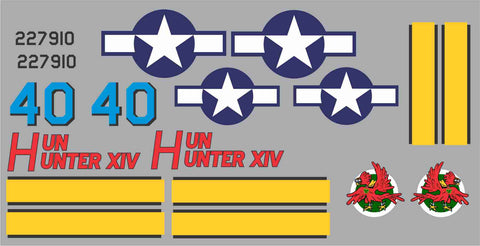P-47D-23-RA, 42-27910, "Hun Hunter XIV", Pilot Lt. Col Gil O. Wymond 65th FS, 57th FG, based in Alto, Corsica, Spring/Summer 1944
Gil Wymond was born on September 23, 1919, in Louisville, Kentucky. After attending the University of Kentucky for two years, he enlisted in the Aviation Cadet Program of the U.S. Army Air Corps on April 25, 1941, and was commissioned a 2d Lt and awarded his pilot wings at Kelly Field, Texas, on December 12, 1941. His first assignment was as a P-40 Warhawk pilot with the 65th Fighter Squadron of the 57th Fighter Group at Bradley Field, Trumbull Field, and Rentschler Field, Connecticut, from December 1941 to July 1942. He then deployed with his squadron aboard the aircraft carrier USS Ranger (CV-4) and took off from the carrier on July 19, 1942, landing at Accra in the Gold Coast before moving to Cairo, Egypt in August 1942. Between August 1942 and May 1945, Lt Col Wymond moved with his squadron through Egypt, Libya, Tunisia, Malta, Sicily, and Italy, and he transitioned from the P-40 to the P-47 Thunderbolt during this time. In addition, he flew 153 combat missions, was credited with the destruction of 3 enemy aircraft in aerial combat plus 2 probables, and served as Commanding Officer of the 65th Fighter Squadron from May 1943 to May 1945, with short periods on leave in the United States from July to September 1943, and May to June 1944. After the war he completed jet transition training in the F-80 Shooting Star and attended Air Command and Staff College at Maxwell AFB, Alabama. Lt Col Wymond took command of the 55th Fighter Squadron at Shaw AFB, South Carolina, in April 1949, and was killed in the crash of his F-84 Thunderjet on May 11, 1949.
Wymond was awarded a silver star for gallantry in action as pilot of a P-47 aircraft. On 2 May, 1944, upon return flight from a successful upon vital enemy communication lines at Rignano, Italy, Lieutenant Colonel Wymond observed activity in a concentration of factory buildings near Montevescala. Immediately leaving his formation, Lieutenant Colonel Wymond dived to minimum altitude in attack and as his accurate fire struck the objective, a tremendous explosion resulted destroying a factory containing large quantities of enemy ammunition. The explosion heavily damaged his aircraft and hurled it more that fifteen hundred feet in the air. Displaying superior flying skill, Lieutenant Colonel Wymond regained control of his shattered plane and returned safely to base. His courage, selfless devotion to duty and outstanding proficiency as a combat pilot reflect great credit upon himself and the Military Service of the United States.

